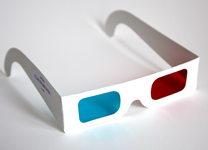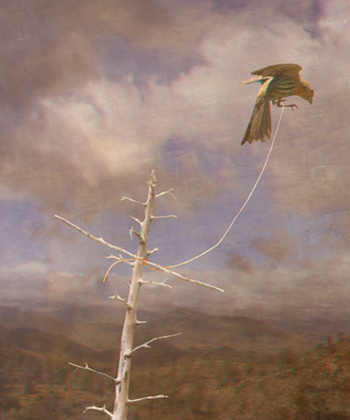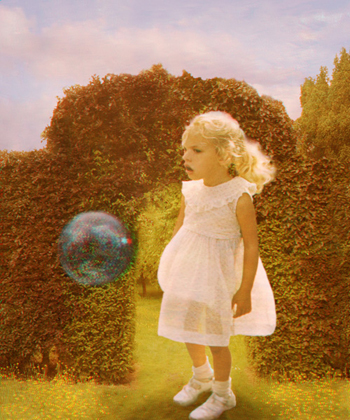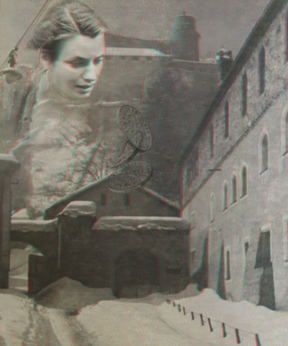Biography, Myth & Time-A Peek at Claudia Kunin
If you attend a Claudia Kunin exhibit, you’ll be given a pair of those funny glasses. Wait a minute, you say, aren’t they for movies? From the 50′s? Isn’t that technology… kind of old?
Actually, it’s ancient. The concept of stereoscopy, the presentation of two very similar pictures, side by side, for combination in the mind, was around long before photography was invented. Principles of depth perception were known to Euclid, and surfaced in the notebooks of Leonardo da Vinci. Other Renaissance artists produced side by side “stereoscopic” drawings, but it wasn’t until 1838 when British Professor Charles Wheatstone invented the stereoscope that people were able to see the dual images as one, with the illusion of depth.
Eleven years later, David Brewster described a binocular camera, and the first stereoscopic pictures were produced. But when he presented Queen Victoria with a stereoscope at the 1851 World’s Fair, the technology exploded into the popular realm. We may associate 3D with 1950′s movies, but by the 1850′s half a million households had a viewer, and until the 1920′s, stereo picture viewing remained a major source of home entertainment.
Back to those glasses. 3D can also be produced by printing two slightly offset negatives, one with the blue/green color info, the other with the red color info into a single image called an anaglyph. Then the red lens/cyan lens glasses recombine the color information, and the slight discrepancy in the placement of the two negatives provides the illusion of depth, like a peek into another world. Which is one effect Claudia Kunin seeks to achieve. But if the technology is old, so are myths and dream, and that really is what her work is all about.
Kunin graduated from the University of Oregon in 1976 with a B.S. in Psychology, and worked for many years as a commercial photographer. But entering her fifties and faced with a serious illness, she took stock and decided she wanted to succeed as a fine artist.
She has. Her work is in the Getty Museum, the Smithsonian, and the Museum of Photographic Arts. Images from her series Family Ghost Stories recently appeared in Sunstruck at the Wall Space Gallery in Santa Barara, a show that also included the work of Robert Heinecken, Edmund Teske, James Fee, Stephen Berkman and Dean Brierly.
The road to this very personal imagery has been long and winding. Kunin always enjoyed photographing old things-haunted places, historic re-eactments. She always loved daguerreotypes, and enjoyed combining antique pictures with pictures of her own. Then there’s that liberation of the 2D surface which she arrived at after various trials: printing images on fabric, then layering them to simulate depth; outsourcing images to make them 3D; then finally learning the 3D process herself, which enabled her to make many other subtle manipulations along the way in Photoshop.
As a child, Kunin loved picture books. “I would go into them, projecting myself into that illustrated space.” As an artist, she speaks of the “natural desire we have to be transported,” ”to walk into the image….3D art makes that possible.”
At earlier points in her work, she incorporated daguerrotypes (3D Ghost Stories) and icons from the tales and myths of Western civilization (3D Holy Ghost Stories). Then a curator confronted her and suggested that she develop a more subtle, personal imagery.
Inspiring images were on hand. When her father died in 2007, Kunin inherited the collection of family photos, many of them stereo views taken with a Stereo Realist camera. She went through them carefully, selecting images that recalled vivid moments from her childhood. Mixing them with images of her own, she felt like she was “collaborating” with her father, “creating personal, familial, mythical tales.” The result was Family Ghost Stories.
A Strange Moment, one piece from this series, includes a picture of Kunin taken by her father when she was three years old.
“I always was VERY interested in what was going on around me…and would stare with a gaping mouth in wonder. My father would warn me that I would catch flies if I kept my mouth open that way.”
Though the snapshot of Kunin was taken on the Redondo Beach pier in California, the grounds in the finished piece are from Hatfield House where Queen Elizabeth the First spent early years, and the floating glass-like orb was fashioned from the image of a horse’s eye. Taken less than twenty-four hours after Kunin survived a near-fatal car accident, this mysterious translucent shape recalls a day that was especially vivid and much appreciated. ”Everything was beautiful, and magical that day,” she said, “as if seen for the very first time. I felt that I had been given another chance at life. A strange moment indeed.”
Chance and fate are also contemplated in a darker light. Probabilities is an homage to her mother and the life she led as a young Jewish woman in Austria after the Anschluss. She worked in a bank and was protected by the bank’s president, who came from a wealthy background and used his influence with a Hitler henchman to keep her safe.
“There was a “Rassen-Amt” or race office where she had to check in every day….it was manned by a Nazi officer….just for her. She was not allowed into the bomb shelters….and had horrific memories of walking around during the bombs, and not being able to help people trapped inside bombed buildings. She also performed slave labor in a factory, making clothing out of burlap for Russian prisoners. But she never had to go to a camp.”
“The coin is an Austrian pfennig….She is watching the coin fall to see what her destiny might be…death in the camps, or meeting my father, and coming to America and having 2 children….either way she will let it be….”
In a world overrun with pictures, where graphics, photos, blaring signage and bright gui icons leap from the sides of buildings, from phones and e-mails, and flash in gaudy ads across our computer screens; where photographs have become so common and pervasive and easy to make that many photographers are not paid, Claudia Kunin’s images remain unique. While they are best appreciated through 3D glasses, they are strong enough to stand on their own. Hovering in a strange shadowland, a place with realistic depth, yet suggestive of some chamber of the human mind where dreams and memories mix with a dash of California sun, they utilize technology, but rise above it. These images are Claudia Kunin’s alone; they belong to nobody else, and you will find them nowhere else in the world.
- Catherine Kirkpatrick, Archives Director





